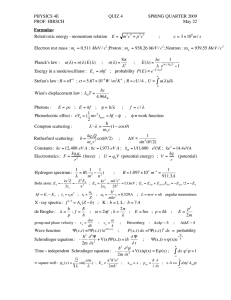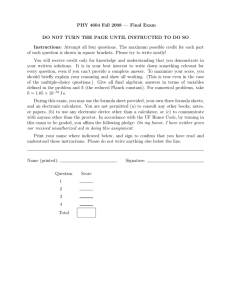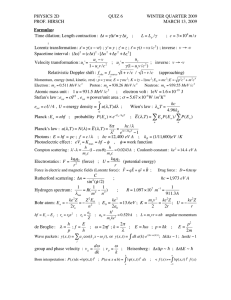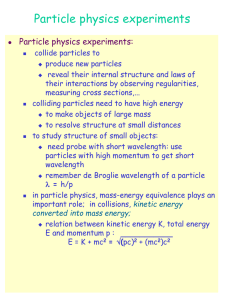PHYSICS 4E QUIZ 5 SPRING QUARTER 2009 PROF. HIRSCH
advertisement
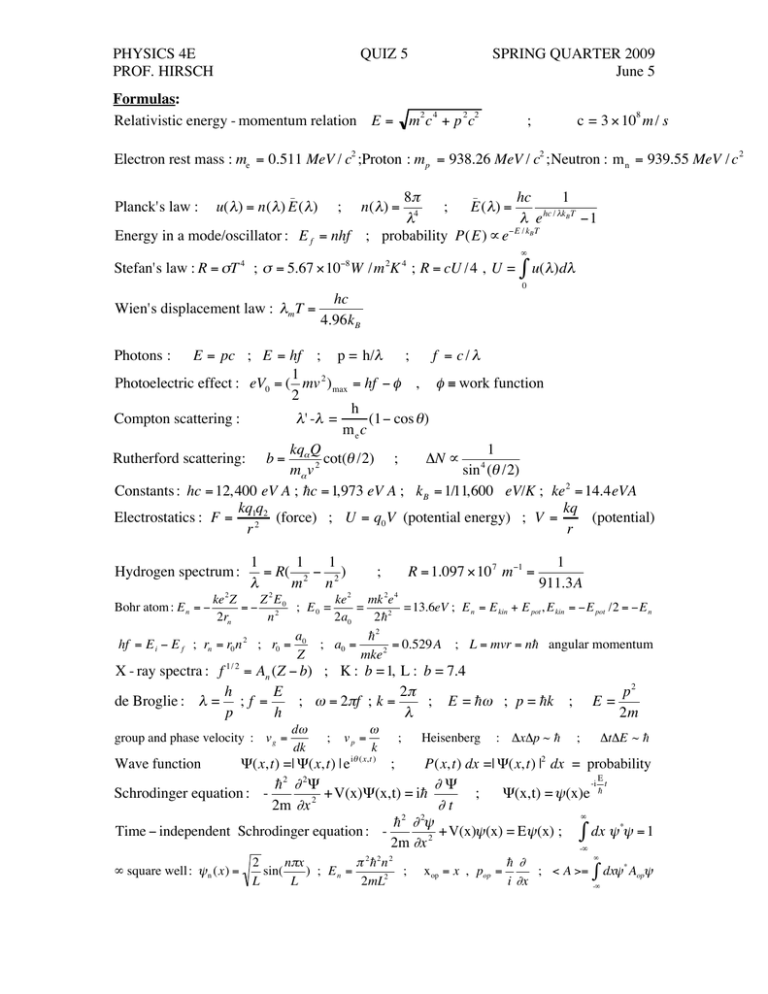
PHYSICS 4E PROF. HIRSCH QUIZ 5 Formulas: Relativistic energy - momentum relation E = SPRING QUARTER 2009 June 5 m2 c 4 + p 2 c2 c = 3 ! 108 m / s ; Electron rest mass : me = 0.511 MeV / c2 ;Proton : mp = 938.26 MeV / c2 ;Neutron : m n = 939.55 MeV / c 2 _ 8# hc 1 ; E ( ") = 4 hc / "kB T " " e $1 Energy in a mode/oscillator : E f = nhf ; probability P(E) " e#E / kB T _ Planck's law : u( ") = n( " ) E ( ") ; n( ") = & ! ! ! ! ! ! Stefan's law : R = "T 4 ; " = 5.67 #10$8 W /m 2K 4 ; R = cU /4 , U = 0 hc Wien's displacement law : "m T = 4.96k B Photons : E = pc ; E = hf ; p = h/! ; f = c/! 1 Photoelectric effect : eV0 = ( mv 2 ) max = hf " # , # $ work function 2 h Compton scattering : ! ' -! = (1" cos # ) me c kq Q 1 "N # 4 Rutherford scattering: b = " 2 cot(# /2) ; m" v sin ($ /2) Constants : hc = 12,400 eV A ; hc = 1,973 eV A ; k B = 1/11,600 eV/K ; ke 2 = 14.4eVA kq q kq Electrostatics : F = 12 2 (force) ; U = q0 V (potential energy) ; V = (potential) r r ! ! Hydrogen spectrum : Bohr atom : E n = " ! ! ! ! ' u(%)d% 1 1 1 = R( 2 # 2 ) " m n R = 1.097 $10 7 m#1 = ; 1 911.3A ke 2 Z Z 2E ke 2 mk 2e 4 = " 2 0 ; E0 = = = 13.6eV ; E n = E kin + E pot , E kin = "E pot /2 = "E n 2rn n 2a0 2h 2 hf = E i " E f ; rn = r0 n 2 ; r0 = a0 Z ; a0 = h2 = 0.529A ; L = mvr = nh angular momentum mke 2 X - ray spectra : f 1/ 2 = An (Z " b) ; K : b = 1, L : b = 7.4 h E 2$ de Broglie : " = ; f = ; # = 2$f ; k = ; E = h# ; p = hk ; p h " group and phase velocity : v g = d" dk ; vp = " k ; Heisenberg : #x#p ~ h E= p2 2m #t#E ~ h ; "(x,t) =| "(x,t) | e i# (x,t ) ; P(x,t) dx =| "(x,t) |2 dx = probability E -i t h2 " 2# "# Schrodinger equation : + V(x)#(x,t) = ih ; #(x,t) = $ (x)e h 2m "x 2 "t % h 2 # 2$ Time " independent Schrodinger equation : + V(x) $ (x) = E $ (x) ; & dx $ *$ = 1 2m #x 2 -% Wave function ! ! ! ! ! ! " square well : # n (x) = 2 n$x $ 2h2n 2 sin( ) ; En = ; L L 2mL2 x op = x , pop = h % ; < A >= i %x " * & dx# A # op -" PHYSICS 4E PROF. HIRSCH QUIZ 5 SPRING QUARTER 2009 June 5 #A = < A 2 > $ < A > 2 Eigenvalues and eigenfunctions : Aop " = a " (a is a constant) ; uncertainty : Harmonic oscillator : "n (x) = Cn H n (x)e ! Step potential : R = ! m$ 2 # x 2h (k1 " k2 ) 2 , (k1 + k2 ) 2 2 1 p 1 1 ; E n = (n + )h$ ; E = + m$ 2 x 2 = m$ 2 A 2 ; %n = ±1 2 2m 2 2 T = 1" R ; k= 2m (E " V ) h2 b % -2 # (x )dx Tunneling : ! " (x) ~ e -#x T ~ e -2#$x ; ; a T~e ; # (x) = 2m[V (x) - E] h2 # 2 h 2 n12 n 22 n 32 ( + + ) 2m L12 L22 L23 Spherically symmetric potential: "n,l,m (r,#, $ ) = Rnl (r)Ylm (#, $ ) ; Ylm (#, $ ) = f lm (# )e im$ r r r h # Angular momentum : L = r " p ; Lz = ; L2Ylm = l(l + 1)h 2Ylm ; L z = mh i #$ Z2 Radial probability density : P(r) = r 2 | Rn,l (r) |2 ; Energy : E n = !13.6eV 2 n 1 Z 3 / 2 $Zr / a 0 Ground state of hydrogen and hydrogen - like ions : "1,0,0 = 1/ 2 ( ) e # a0 " " #e eh Orbital magnetic moment : µ = L ; µz = #µB ml ; µB = = 5.79 $10#5 eV /T 2me 2me r 1 "e r Spin 1/2 : s = , | S |= s(s + 1)h ; Sz = msh ; ms = ±1/2 ; µs = gS 2 2me 3D square well : "(x,y,z) = "1 (x)"2 (y)"3 (z) ; E = ! ! ! ! ! r r r Total angular momentum : J = L + S ; | J |= j( j + 1)h ; | l " s |# j # l + s ; " j # m j # j r r "e r r r Orbital + spin mag moment : µ= ( L + gS ) ; Energy in mag. field : U = "µ # B 2m Two particles : "(x1, x 2 ) = + /# "(x 2 , x1 ) ; symmetric/antisymmetric Screening in multielectron atoms : Z ! Z eff , 1 < Z eff < Z Orbital ordering: 1s < 2s < 2p < 3s < 3p < 4s < 3d < 4p < 5s < 4d < 5p < 6s < 4f < 5d < 6p < 7s < 6d ~ 5f ! ! ! ! ! # In (! ) = $ dx xn e" !x 2 ; I0 = 0 f MB (E) = Ce"E / kT ; f BE (E) = 1 # E / kT e e F(vx , vy , vz ) = f (vx ) f (v y ) f (vz ) ! L2 Rotation : E = , I = µR2 , R 2I 1 % 1 ; I1 = 2 ! 2! ; "1 ; f FD (E) = f (v x ) = ( ; I n+2 = " 1 # E / kT e e +1 m 1/ 2 " mv ) e 2!kT 2 x & In &! ; / 2kT 1 vibration : E = h" (n + ), " = K / µ , v 2 n(E) = g(E) f (E) (kinetic theory) µ = m m /(m + m ) 1 2 1 2 g(E) = [2" (2m) 3/2 V /h 3 ]E1/2 (translation, per spin) ; Equipartition : < E >= k T /2 per degree of freedom B Lasers: B12 = B21 , A21 /(B21u( f )) = e hf / kT "1 ; u( f ) = (8#hf 3 /c 3 ) /(e hf / kT "1) Justify all your answers to all problems ! ! ! PHYSICS 4E PROF. HIRSCH QUIZ 5 SPRING QUARTER 2009 June 5 Problem 1 (10 pts) 1mol of Ne gas (monatomic) occupies a volume 8cm3. The atomic weight of Ne is 20, and its total spin is 0, so it's a boson. (a) Give the average kinetic energy (in eV) of a Ne atom in this gas at temperature 300oK. (b) Estimate the de Broglie wavelength (in A) for a Ne atom in this gas at 300oK. (c) Explain why you can use the Maxwell-Boltzmann distribution for this gas at temperature 300K. (d) Estimate at what temperature (in oK) quantum effects will become sufficiently important that you can no longer use the Maxwell Boltzmann distribution for this gas (assuming the system remains a gas rather than becoming liquid or solid). Problem 2 (10 pts) Consider a system of N distinguishable particles that has only two possible energy states. Each particle can be in an energy state of energy E1=0 or in energy states of energy E2=ε=4.4 eV. The statistical weight (degeneracy) is g1=1 for the state of energy E1 and g2=9 for the states of energy E2 . No other states are available for these particles. Use the Boltzmann distribution since the particles are distinguishable. (a) At what temperature are there on average an equal number of particles with energy E1 as there are with energy E2? Give your answer in oK. (b) What is the average energy per particle at the temperature found in (a)? Give your answer in eV. (c) What is the average energy per particle as T--> oo? (very high temperature). Give your answer in eV. (d) For one mol of this system, estimate the heat capacity CV at temperature 300oK. Your estimated answer should not differ from the exact answer by more than 0.1R, with R the gas constant (R=NAk, NA=6.02x1023). Problem 3 (10 pts) The heat capacity of 1 mol of a diatomic gas has values: CV=1.5R at temperature T=5K. CV=2.4R at temperature T=10K. CV=2.8R at temperature T=100K. The distance between the two atoms in the molecule is 1.5A. The two atoms are identical. (a) Estimate the atomic weight of the atoms in this molecule. Justify your answer. (b) Estimate the vibration frequency of this molecule, in s-1. ( Use h = 6.58 "10#16 eV s or h = 4.136 "10#15 eV s ) (c) Estimate the value of its heat capacity at T=2K, assuming the system remains a gas at T=2K. ! Justify all your answers to all problems
